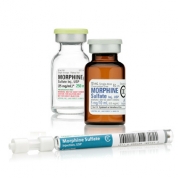Morphine

Description
Morphine is the most abundant opiate found in opium, the dried latex extracted by incising the seedpods of the ‘Papaver somniferum’ poppy. Morphine is one of at least 50 alkaloids (codeine, papaverine, noscapine, thebane etc. ) present in opium and poppy straw. Morphine however, is the ‘daddy’ of the family.
In clinical medicine, morphine is regarded as the gold standard, or benchmark, of opioid analgesics used to relieve severe, chronic or terminal pain. Like other opioids, such as oxycodone and diacetylmorphine (heroin), morphine acts directly on the central nervous system (CNS) to relieve pain.
Morphine can be taken orally, sublingually, bucally, rectally, subcutaneously, intravenously, and inhaled via a nebulizer. Morphine is subject to extensive first-pass metabolism (a large proportion is broken down in the liver), so, if taken orally, only 40–50% of the dose reaches the central nervous system.
For general advice, including harm reduction, see our 'safer injecting' section here.
The effects of morphine can be countered with opioid antagonists such as naloxone and naltrexone and the development of tolerance to morphine may be inhibited by NMDA antagonists. See the appropriate section on these substances.
Morphine can be found as a powder, white or off-white to grey and comes in a huge variety of pills, slow release tablets, capsules, granules, ampoules, suppositories and elixirs.
